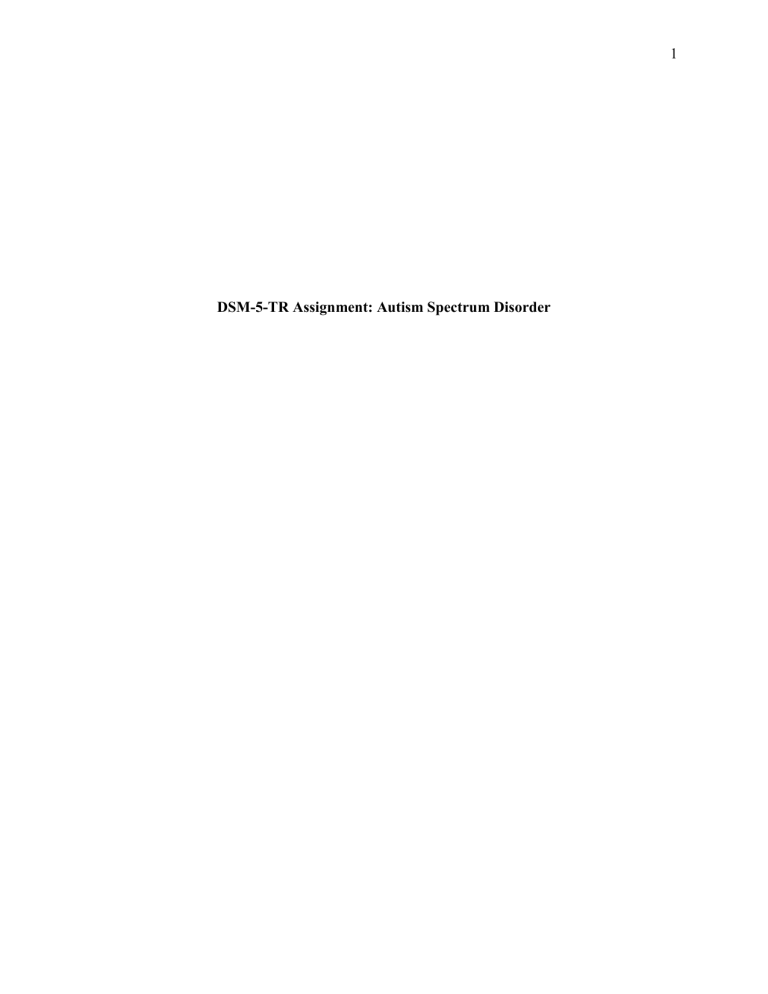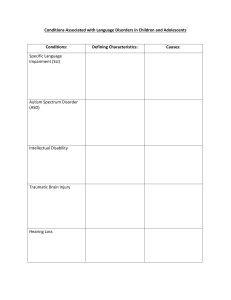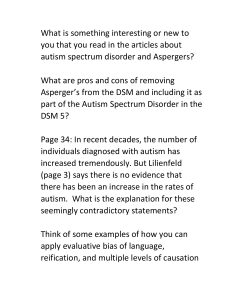
1 DSM-5-TR Assignment: Autism Spectrum Disorder 2 DSM-5-TR Assignment: Autism Spectrum Disorder Introduction A person with autism spectrum disorder (ASD) struggles with social interaction, behavior, and cognitive performance. ASD is a complicated condition that manifests uniquely in each person and has various levels of severity. It has become more common; according to the CDC, 1 in 36 has been identified with autism spectrum disorder (ASD). Making it difficult to establish and sustain social connections is one of the effects of ASD on a person's social performance. Individuals with ASD may struggle to understand social signals and norms, as well as nonverbal communication skills such as eye contact and reading facial expressions. To diagnose ASD, a team of experts, including doctors, neurologists, psychologists, and speech therapists, conducts a thorough assessment. The Autism Diagnostic Observation Schedule (ADOS) and the Autism Diagnostic Interview-Revised (ADI-R) are two tools available for diagnosis. Various forms of treatment, such as behavioral therapy, speech and language therapy, and vocational therapy, are used to help people with an autism spectrum disorder. These programs are designed to boost emotional, behavioral, and mental health. The potential of pharmacological treatments to alleviate some of the fundamental symptoms of ASD is also the subject of continuing study. Thus, successful treatments can be informed by discussing the current knowledge of ASD, including identification, incidence, impact on social functioning, and evaluation methods. Autism Spectrum Disorder Diagnosis The ASD Diagnostic Criteria Both chronic difficulties with social speech and engagement, as well as limited, repeated patterns of behavior, interests, or activities, are required for an ASD diagnosis, according to the DSM-5 (Cherry, 2021). These difficulties in social and work performance begin in early infancy. 3 Clinicians also need to think about the disorder's intensity degree, which can range from "level 1" (needing support) to "level 3" (requiring very substantial support). Misdiagnosis and Stigma Misdiagnosis of autism spectrum disorder (ASD) is a forwarding issue, especially in culturally varied societies where various forms of anxiety may be interpreted differently. Misdiagnosis of autism spectrum disorder may occur because some societies consider certain repetitious habits or little hobbies normal or desirable (Lounds Taylor et al., 2016). Social workers should also be mindful that they may be contributing to the isolation of people with ASD by contributing to the spread of myths and stereotypes about the condition. One instrument that can help social workers comprehend how cultural variables may play a role in the appearance and identification of ASD is the cultural formulation interview (CFI) (Cherry, 2021). Diagnostic Distinction Identifying and differentiating ASD from other clinical conditions with comparable signs requires differential evaluation. Social communication disorder (SCD) and attentiondeficit/hyperactivity disorder (ADHD) are two conditions that may be evaluated in an alternative diagnostic. Disabilities in social contact, such as trouble starting or continuing talks, have been linked to SCD and ADHD. However, SCD does not exhibit the limited, repeated patterns of behavior typical of ASD, and greater instances of restlessness and recklessness characterize ADHD (Cherry, 2021). Rates of Prevalence of Autism Spectrum Disorder Autism spectrum disorder (ASD) has increased in frequency over the past few years and now impacts people of all ages and socioeconomic backgrounds. The CDC estimates that by 2020, one in every 54 American infants will have autism spectrum disorder (ASD), up from 1 in 125 in 4 2010 (CDC, 2021). When looking at gender roles, men are more likely to receive a diagnosis of ASD than females. According to the CDC, 1 in 34 boys and 1 in 144 girls are identified with an autism spectrum disorder (CDC, 2021). However, a new body of research suggests that ASD may be underreported in females due to variations in appearance and diagnosis criteria (May et al., 2020). People of all racial and class backgrounds are at risk for developing ASD. Children of minority ethnic groups may be less likely to receive a diagnosis or receive a late diagnosis than children of majority ethnic groups, according to studies (Lounds Taylor et al., 2016). This is partially due to, children of minority ethnic groups being misdiagnosed with other disorders such as conduct disorder. Further study is required to grasp the connection between ASD and social position completely. Still, some studies indicate that children from poorer-income households may have a greater chance of having ASD (CDC, 2021). The link between autism spectrum disorder and gender expression has recently emerged. A growing body of research suggests that people on the autism spectrum may be overrepresented among transsexual and gender- nonconforming people (May et al., 2020). Still, there is a lack of data on the frequency and lived experiences of people with ASD and gender identification issues. Social Impairment Associated with Autism Spectrum Disorder As a neurological condition, autism spectrum disorder (ASD) can have far-reaching consequences for a person's ability to interact socially in their everyday life. An individual's social performance can be measured by how well they get along with others, how well they can express themselves in conversation, and how well they can form and maintain friendships. Individuals with ASD may have trouble communicating and interacting socially with family members in the household setting. They may have trouble reading facial expressions and 5 body language, have little hobbies, or have physiological issues that make it difficult to communicate with others. Children with ASD may have trouble in school due to issues with social contact, speech, and appropriate habits that can affect their grades and well-being (Huang et al., 2017). Difficulties in the workplace and fewer employment prospects can arise for people with ASD due to difficulties in social relationships with coworkers, understanding social signals, and issues with physical hypersensitivity (Huang et al., 2017). People on the autism spectrum may have trouble forming and maintaining meaningful relationships due to social encounters, communication, and emotional control challenges (Moseley et al., 2021). Co-occurring disorders like anxiety, depression, and attention deficit hyperactivity disorder can further complicate social performance for people with ASD. Tools for Evaluating Individuals with Autism Use proper evaluation tools to learn about your client's assets and weaknesses when dealing with autistic spectrum disorder (ASD). The ADOS-2 Autism Diagnostic Observation Schedule and the Social Responsiveness Scale are possible instruments for conducting diagnostic evaluations (SRS-2). The ADOS-2 is a semi-structured, regulated evaluation used to identify ASD and measure social speech and relationship abilities in people of all ages (McIntyre et al., 2017). It is given via a battery of exercises to bring out target patterns of interaction and communication. The ADOS-2 offers a systematic way to evaluate an individual's strengths and flaws in social and communication contexts through systematic observation and grading. Caregivers and educators can use the SRS-2 scoring measure to determine how severe a child's ASD-related social deficits are (McIntyre et al., 2017). It has 65 questions that evaluate autism traits, social consciousness, social reasoning, social dialogue, and social drive. Because it offers a controlled measure of social functioning that can be used to monitor changes 6 over time and evaluate the efficacy of treatments, the SRS-2 is a valuable instrument for evaluating social problems and deficits in people with ASD. When used together, the ADOS-2 and the SRS-2 can shed light on a person's social dialogue and relationship abilities and how they perform in everyday life. These evaluation tools can create tailored therapy programs and monitor outcomes over time. For a complete picture of the individual's strengths and challenges, it is recommended that these assessments be used in conjunction with clinical judgment and other sources of information, such as interviews with caregivers and observations of the individual in different settings. Therapies for Individuals with Autism Neurodevelopmental disorders like autism spectrum disorder (ASD) negatively affect social contact and speech. Psychosocial and psychopharmacological treatments are possible components of a comprehensive approach to treating autism spectrum disorder (ASD). Cognitivebehavioral treatment (CBT) and risperidone are viable options for treating autism spectrum disorder (ASD). Short-term and organized cognitive behavioral treatment (CBT) aims to better emotional control and social skills by modifying bad thought patterns and behaviors. Social skills training and worry reduction are two areas where CBT can be modified to serve people with ASD better. Risperidone is a psychopharmacological strategy authorized by the Food and Drug Administration (FDA) to manage agitation and aggressive behavior in children and teenagers with an autism spectrum disorder (Sohn et al., 2016). The atypical antipsychotic risperidone blocks dopamine receptors in the brain. Weight increase, lethargy, and movement problems (e.g., tardive dyskinesia) are potential negative effects of risperidone, which successfully decreases anger and hostility in people with ASD (Sohn et al., 2016). When considering the use of 7 psychopharmacological treatments, it is crucial to conduct a risk assessment. Careful tracking of adverse effects is required to ensure that the advantages of the medicine exceed the risks. Individuals with ASD should receive a multimodal therapy plan, including psychological and psychopharmacological treatments. Therefore, managing ASD successfully requires a multimodal strategy incorporating psychological and psychopharmacological treatments. Anxiety can be treated with cognitive behavioral therapy (CBT), and restlessness can be treated with risperidone. Other treatments, such as social skills training and caregiver instruction, can be implemented if psychopharmacological intervention is not warranted. Individuals with ASD should receive a multimodal treatment plan that includes psychopharmacological therapies, which should be used cautiously due to the risk of adverse effects and in combination with other treatments. Conclusion Individuals with Autism Spectrum Disorder (ASD) struggle in many areas of life, including interpersonal relationships, self-care, and intellectual growth. When making a prognosis, it is important to consider symptoms, possible causes, and societal context. Social workers can use the cultural formulation interview (CFI) to handle misdiagnosis and bias in culturally and linguistically varied areas. An individual's social performance may be affected by ASD in various settings, including the family, the classroom, and the workplace. Interventions for ASD, like behavioral therapy, speech and language therapy, and physical therapy, seek to enhance social dialogue, behavior, and cognitive performance. Some fundamental signs of autism spectrum disorder (ASD) are being investigated as treatable by pharmaceutical treatments. Effective treatments can be created to better the lives of people with ASD and their families as more study is done on ASD, including co-occurring illnesses and varied groups. 8 References 9 Centers for Disease Control and Prevention. (2021, December 2). Data & statistics on autism spectrum disorder. Centers for Disease Control and Prevention. https://www.cdc.gov/ncbddd/autism/data.html Cherry, K. (2021). Diagnostic and Statistical Manual (DSM) Overview. Verywell Mind. https://www.verywellmind.com/the-diagnostic-and-statistical-manual-dsm-2795758 Huang, A. X., Hughes, T. L., Sutton, L. R., Lawrence, M., Chen, X., Ji, Z., & Zeleke, W. (2017). Understanding the Self in Individuals with Autism Spectrum Disorders (ASD): A Review of Literature. Frontiers in Psychology, 8. https://doi.org/10.3389/fpsyg.2017.01422 Lounds Taylor, J., Adams, R. E., & Bishop, S. L. (2016). Social participation and its relation to internalizing symptoms among youth with autism spectrum disorder as they transition from high school. Autism Research, 10(4), 663–672. https://doi.org/10.1002/aur.1709 May, T., Brignell, A., & Williams, K. (2020). Autism Spectrum Disorder Prevalence in Children Aged 12–13 Years from the Longitudinal Study of Australian Children. Autism Research. https://doi.org/10.1002/aur.2286 McIntyre, N. S., Solari, E. J., Grimm, R. P., Lerro, L. E., Gonzales, J. E., & Mundy, P. C. (2017). A Comprehensive Examination of Reading Heterogeneity in Students with High Functioning Autism: Distinct Reading Profiles and Their Relation to Autism Symptom Severity. 04-00. Moseley, R. L., Turner-Cobb, J. M., Spahr, C. M., Shields, G. S., & Slavich, G. M. (2021). Lifetime and perceived stress, social support, loneliness, and health in autistic adults. Health Psychology, 40(8), 556–568. https://doi.org/10.1037/hea0001108 10 Sohn, M., Moga, D. C., Blumenschein, K., & Talbert, J. (2016). National trends in off-label use of atypical antipsychotics in children and adolescents in the United States. Medicine, 95(23), e3784. https://doi.org/10.1097/md.0000000000003784


